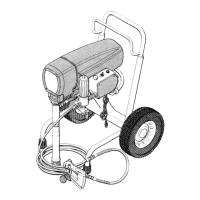TR()UBLESHOOTlNG GUIDE,~.,r,.. ,.? :; ;: ;z.<!:.tr”.z “I,.: ,,;:ijv :I,.> ; ‘r:,“ir’i”ii::i,,;,. ;~$$~;i;~\r”$f;;c;;
This guide will help you identify the causes and solu-
dicated, contact your nearest authorized service agency
tions to sprayer problems. If you cannot identify and
for instructions on where and how to return the sprayer
resolve the Droblem. or if “Return for reoair” is in-
for reoair.
Pressure Relief Procedure
,To reduce the risk of serious bodily injury, in-
eluding injection or injury from moving parts or
electric shock, always follow this procedure,
whenever you shut off the sprayer, when check-
ing or servicing any part. of the spray system,
when installing, cleaning or changing spray tips,
and whenever you stop spraying.
of a metal pail, and trigger the gun to relieve
pressure.
6. Engage the gun safety latch.
7. Open the drain valve, having a container
ready to catch the drainage.
8. Leave the drain valve open until you are ready
to spray again.
If you suspect that the spray tip or hose is com-
1. Engage the gun safety latch.
pletely CLOGGED, OR THAT PRESSURE HAS
2. Turn the ON/OFF switch to OFF.
NOT BEEN FULL Y RELIEVED after following the
3. Unplug the power supply cord.
steps above,
VERY SLOWLY loosen the tip guard
4. Disengage the gun safety latch.
retaining nut or hose end coupling and relieve
5. Hold a metal part of the gun firmly to the side
pressure gradually. Then loosen the nut complete-
ly. Now clear the tip or hose obstruction.
PROBLEM
I. Electric motor won’t operate
II. Electric motor stops while spraying
III. Electric motor runs, but output low
(See Problem VII also.)
IV. Electric motor runs, but no output
and pump not stroking
1. Drive assemby damaged
V. Paint leaks into wet-cup
1. Packing nut too loose
VI. Excessive surge (pulsing) at spray
gun
CAUSE
1. Power cord unplugged, or
building circuit fuse blown
2. Current overload circuit breaker
has opened
3. Pressure setting too low
4. Damaged extension cord
5. Motor brushes worn
6. Pressure control damaged by
freezing (b) or overpressurizing
(cl
7. Material or water frozen in
sprayer (b)
1. Power cord unplugged, or
building circuit fuse blown
2. Pressure setting too low
3. Tip or filter plugged
4. Pressure control or motor failure
1. Piston ball check not seating
2. Piston packing worn or damaged
3. Intake valve ball check not
seating
4. Displacement pump frozen (b) or
gear train damaged
5. Pressure control frozen (b) or
damaged by over-pressurization
(cl
2. Throat packings worn or
damaged
3. Damaged or worn piston rod
1. Filter partially clogged
2. Spray tip too big or worn
3. Paint too thick
4. Wrong type hose
5. Displacement pump check balls
dirty or sticking
6. Displacement pump check balls
and packings worn or damaged
7. Pressure control or motor
damaged
SOLUTION
1. Check,
reset or
replace.
2. Depress reset button on top of
pressure control (a).
3. Increase.
4. Replace.
5.
Replace. See page 18.
6. Return for repair.
7. Thaw; try to start; return for
repair if needed.
1. Check, reset or replace.
2. Increase.
3. Remove and clean.
4. Return for repair.
1. Repair. See page 15.
2. Replace. See page 15.
3. Repair. See page 15.
4. Thaw; restart; return for repair if
needed.
5. Thaw; restart; return for repair if
needed.
1. Return for repair.
1. Tighten just enough to stop
leakage.
2. Repl?ce (d). See page 15.
3. Replace (d). See page 15.
1. Remove and clean.
2. Change tip.
3. Thin per paint manufacturer’s
recommendations.
4. Use minimum 50 ft (15.2 m)
grounded nylon hose; do not use
wire braid hose.
5. Flush, then remove and clean if
needed.
6. Replace. See page 15.
7. Return for repair.
14
307-643

